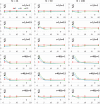Genome evolution by matrix algorithms: cellular automata approach to population genetics
- PMID: 24723728
- PMCID: PMC4007542
- DOI: 10.1093/gbe/evu075
Genome evolution by matrix algorithms: cellular automata approach to population genetics
Abstract
Mammalian genomes are replete with millions of polymorphic sites, among which those genetic variants that are colocated on the same chromosome and exist close to one another form blocks of closely linked mutations known as haplotypes. The linkage within haplotypes is constantly disrupted due to meiotic recombination events. Whole ensembles of such numerous haplotypes are subjected to evolutionary pressure, where mutations influence each other and should be considered as a whole entity-a gigantic matrix, unique for each individual genome. This idea was implemented into a computational approach, named Genome Evolution by Matrix Algorithms (GEMA) to model genomic changes taking into account all mutations in a population. GEMA has been tested for modeling of entire human chromosomes. The program can precisely mimic real biological processes that have influence on genome evolution such as: 1) Authentic arrangements of genes and functional genomic elements, 2) frequencies of various types of mutations in different nucleotide contexts, and 3) nonrandom distribution of meiotic recombination events along chromosomes. Computer modeling with GEMA has demonstrated that the number of meiotic recombination events per gamete is among the most crucial factors influencing population fitness. In humans, these recombinations create a gamete genome consisting on an average of 48 pieces of corresponding parental chromosomes. Such highly mosaic gamete structure allows preserving fitness of population under the intense influx of novel mutations (40 per individual) even when the number of mutations with deleterious effects is up to ten times more abundant than those with beneficial effects.
Keywords: SNPs; fixation; gene; genomics; linkage; neutral theory.
Figures








Similar articles
-
Maruyama's allelic age revised by whole-genome GEMA simulations.Genomics. 2015 May;105(5-6):282-7. doi: 10.1016/j.ygeno.2015.02.005. Epub 2015 Feb 21. Genomics. 2015. PMID: 25708667
-
Haplotypes histories as pathways of recombinations.Bioinformatics. 2004 Aug 12;20(12):1836-41. doi: 10.1093/bioinformatics/bth148. Epub 2004 Feb 26. Bioinformatics. 2004. PMID: 14988100
-
Recovering haplotype structure through recombination and gene conversion.Bioinformatics. 2005 Sep 1;21 Suppl 2:ii173-9. doi: 10.1093/bioinformatics/bti1128. Bioinformatics. 2005. PMID: 16204098
-
Unraveling recombination rate evolution using ancestral recombination maps.Bioessays. 2014 Sep;36(9):892-900. doi: 10.1002/bies.201400047. Epub 2014 Jul 14. Bioessays. 2014. PMID: 25043668 Free PMC article. Review.
-
Evolutionary genomics: reading the bands.Bioessays. 2000 Feb;22(2):105-7. doi: 10.1002/(SICI)1521-1878(200002)22:2<105::AID-BIES1>3.0.CO;2-S. Bioessays. 2000. PMID: 10655029 Review.
Cited by
-
Atlas of Cryptic Genetic Relatedness Among 1000 Human Genomes.Genome Biol Evol. 2016 Feb 23;8(3):777-90. doi: 10.1093/gbe/evw034. Genome Biol Evol. 2016. PMID: 26907499 Free PMC article.
-
Inference of distant genetic relations in humans using "1000 genomes".Genome Biol Evol. 2015 Jan 7;7(2):481-92. doi: 10.1093/gbe/evv003. Genome Biol Evol. 2015. PMID: 25573959 Free PMC article.
-
Intricacies in arrangement of SNP haplotypes suggest "Great Admixture" that created modern humans.BMC Genomics. 2017 Jun 5;18(1):433. doi: 10.1186/s12864-017-3776-5. BMC Genomics. 2017. PMID: 28583085 Free PMC article.
-
Nucleotide Composition of Ultra-Conserved Elements Shows Excess of GpC and Depletion of GG and CC Dinucleotides.Genes (Basel). 2022 Nov 7;13(11):2053. doi: 10.3390/genes13112053. Genes (Basel). 2022. PMID: 36360290 Free PMC article.
-
Adapting Biased Gene Conversion theory to account for intensive GC-content deterioration in the human genome by novel mutations.PLoS One. 2020 Apr 30;15(4):e0232167. doi: 10.1371/journal.pone.0232167. eCollection 2020. PLoS One. 2020. PMID: 32353016 Free PMC article.
References
Publication types
MeSH terms
LinkOut - more resources
Full Text Sources
Other Literature Sources

